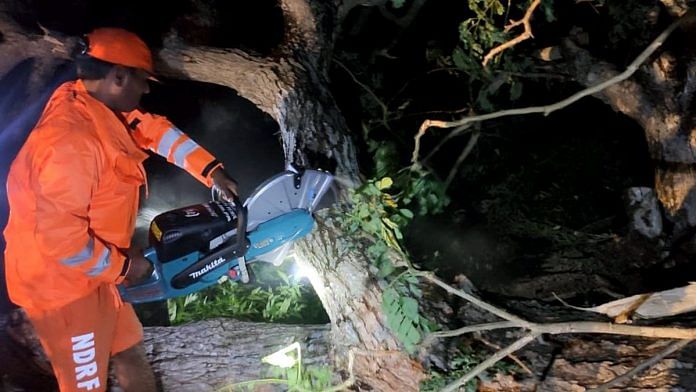Bengaluru: Cyclone Gulab, which made landfall in Andhra Pradesh and Odisha Sunday night, marked an aberration as far as the climate calendar goes.
In the 22 years of the 21st century, it is only the third cyclone to make landfall in September, during the active monsoon season — when temperatures across the Bay of Bengal are expected to be lower than conducive for cyclone intensification.
The two other September cyclones from the Bay of Bengal (BOB) so far have been Cyclone Pyarr, which made landfall in Andhra Pradesh on 19 September 2005, and Cyclonic Storm Daye, which hit Odisha on 21 September 2018.
Tropical cyclones around the subcontinent form in the months of March to June, and then from October to December. Most of these storms form in the Bay of Bengal, due to higher sea surface temperatures as compared to those in the Arabian Sea, which sees far fewer cyclones.
The warmth leads to evaporation of moisture-laden air, which rises, with cool air rushing in below. Under favourable conditions, this process repeats and a storm develops, and intensifies to a cyclone.
In the Bay of Bengal, cyclones are more common in the post-monsoon season.
In the monsoon season, the intensification or increase in strength and wind speeds is usually dampened by what is called “vertical wind shear” or the difference in the speeds and direction of winds at different altitudes.
“Generally, the monsoon conditions are not favourable for cyclones to develop in the North Indian Ocean,” explained Roxy Mathew Koll, climate scientist at the Indian Institute of Tropical Meteorology and contributing author for the IPCC’s Sixth Assessment Report (AR6), published in August.
“This is because of the strong opposing winds in this region — the lower atmospheric winds are in one direction (southwesterly) and the upper atmospheric winds are in the other direction (northeasterly). This prevents a cyclone from developing vertically.”
Multiple factors, including “warmer ocean conditions”, are now assisting cyclone formation during the onset (June-July) and withdrawal of monsoon (September), when the monsoon is not at its peak, he said.
“This time, the remnants of the cyclone (the rotational element) in the South China Sea came to the Bay of Bengal. In the Bay of Bengal, the ocean-atmospheric conditions were favourable for the cyclone to re-emerge again, as cyclone Gulab. Now, Gulab has weakened as it crosses land (since heat and moisture from the ocean is cut-off). But as it reaches the Arabian Sea, it is warm and humid over there, again raising the possibility of it re-emerging it as a cyclone.”
Cyclone Gulab brought with it severe winds and rains over Andhra and Odisha. The cyclone weakened into a deep depression at 2.30 am Monday, and continued to weaken as it moved in the west-northwest direction.
While the landfall made by Gulab is unusual, the formation of a depression or a storm in the ocean itself is not.
Other storms and depressions that did not reach cyclonic strength have formed occasionally in the Bay of Bengal. A day-long depression called Depression BOB 05 struck Andhra Pradesh in September 1991 before dissipating.
Smaller storms struck the east coast in 1970 and 1981, while depressions have formed over the ocean without hitting land on many occasions since 1838.
Also Read: Media reporting is taking people away from the climate crisis. Our approach needs a reset
Monsoon withdrawal delayed too
Apart from the unusual cyclonic storm patterns, the monsoon patterns in India are changing too.
The withdrawal of the southwest monsoon (June-September) is officially considered to have begun if there are no rains for five continuous days in the northwestern parts of India. This process typically begins to occur from mid-september.
However, this season, the first withdrawal is likely to start from parts of Rajasthan only in the first week of October, the India Meteorological Department (IMD) has said. Withdrawal of monsoon has been getting delayed every year since 2017, which subsequently delays the onset of winter.
The unusual and fluctuating weather patterns are indicative of the realities of global warming, with early predicted scenarios already playing out.
According to the IPCC’s Sixth Assessment Report, the Indian monsoon is expected to become more intense — coming in frequent short bursts of very heavy rainfall, but with the overall number of rainy days decreasing despite a “lengthening” of monsoon.
”We do see a delay in withdrawal in monsoon in some of the years, but there is no clarity on whether this is a trend,” said Koll. “But, yes, there are visible changes in the onset and withdrawal — and also generally in the monsoon pattern.”
(Edited by Sunanda Ranjan)
Also Read: These are the ‘code red’ warnings in IPCC climate change report, & why it matters



